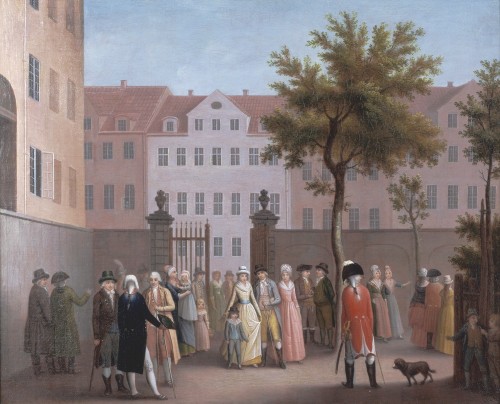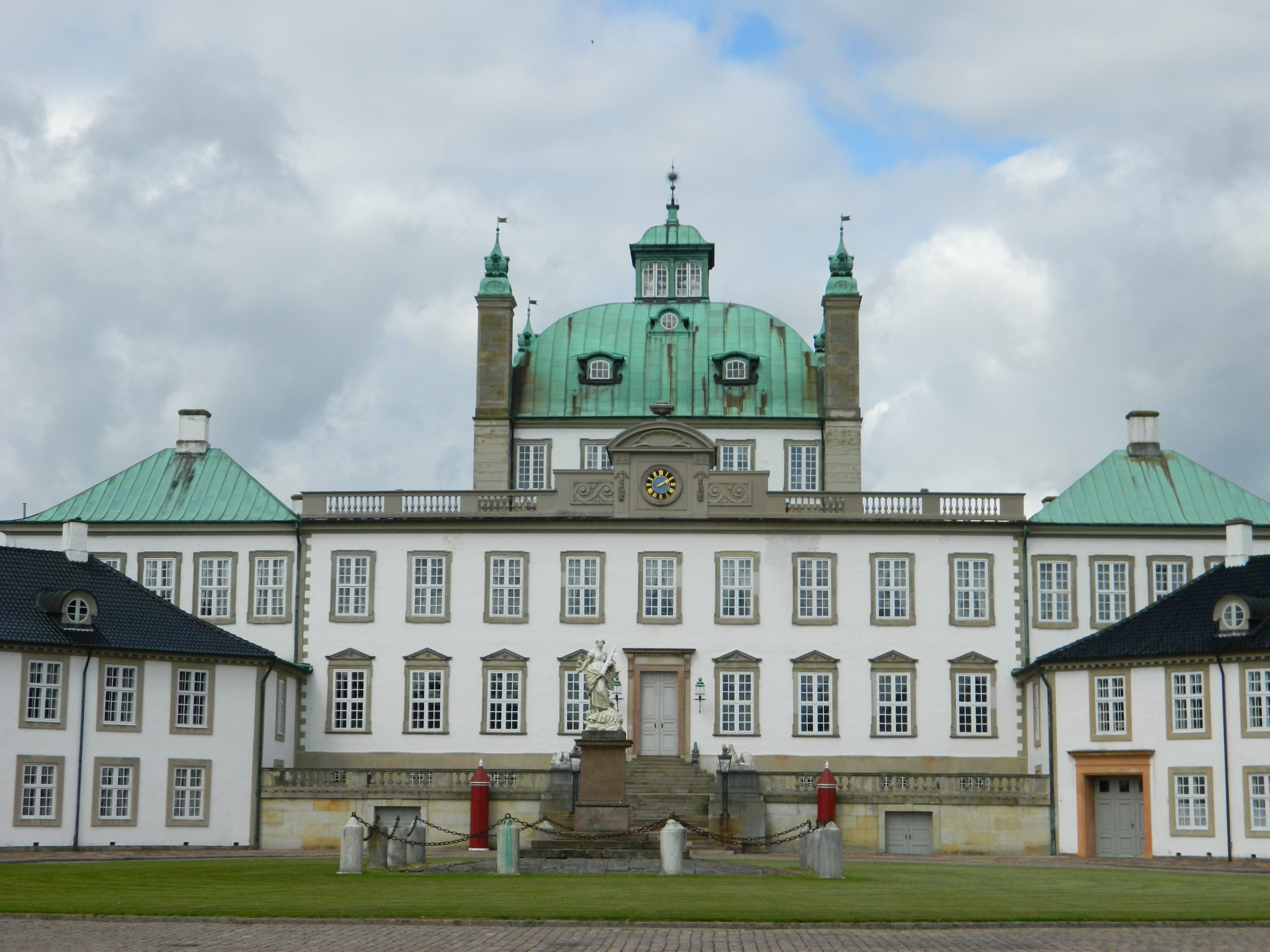|
Kongens Have
Rosenborg Castle Gardens (Danish: Kongens Have literally The King's Garden) is the oldest and most visited park in central Copenhagen, Denmark. Established in the early 17th century as the private gardens of King Christian IV's Rosenborg Castle, the park also contains several other historical buildings, including Rosenborg Barracks, home to the Royal Guards, as well as a high number of statues and monuments. The park also holds art exhibitions and other events such as concerts in the summer. History The Renaissance gardens The park traces its history back to 1606 when King Christian IV acquired land outside Copenhagen's East Rampart and established a pleasure garden in Renaissance style which also delivered fruit, vegetables and flowers for the royal household at Copenhagen Castle. The garden had a relatively small pavilion which was later expanded into present day Rosenborg Castle which was completed in 1624. In 1634, Charles Ogier, secretary to the French ambassador to Denmark, ... [...More Info...] [...Related Items...] OR: [Wikipedia] [Google] [Baidu] |
Rosenborg Castle
Rosenborg Castle ( da, Rosenborg Slot) is a renaissance architecture, renaissance castle located in Copenhagen, Denmark. The castle was originally built as a country summerhouse in 1606 and is an example of Christian IV of Denmark, Christian IV's many architectural projects. It was built in the Renaissance architecture, Dutch Renaissance style, typical of Danish buildings during this period, and has been expanded several times, finally evolving into its present condition by the year 1624. Architecture, Architects Bertel Lange and Hans van Steenwinckel the Younger are associated with the structural planning of the castle. History The castle was used by Danish regents as a royal residence until around 1710. After the reign of Frederick IV of Denmark, Frederik IV, Rosenborg was used as a royal residence only twice, and both these times were during emergencies. The first time was after Christiansborg Palace burned down in 1794, and the second time was during the Battle of Copenhagen ( ... [...More Info...] [...Related Items...] OR: [Wikipedia] [Google] [Baidu] |
Johan Cornelius Krieger
Johan Cornelius Krieger (1683–1755) was a Danish architect and landscape architect, who from the 1720s served as both the country's chief architect, and head of the royal gardens. Krieger oversaw the construction of Fredensborg Palace and its gardens, as well as an expansion of Frydenlund Manor. He also designed or redeveloped the gardens of Frederiksberg Palace (now Frederiksberg Park), Clausholm Castle, Rosenborg Castle, Hirschholm Palace, and Odense Palace. Following the Copenhagen Fire of 1728, he was involved in the plan to reconstruct the city using brick-faced houses, establishing by March 1729 a brick works and, in partnership with Vice Admiral Ulrich Kaas, a lime kiln and a sawmill in Christianshavn He was an exponent of the baroque architecture and was influenced by the French formal garden style of André Le Nôtre. Personal life On 8 March 1712, he married Anna Matthisen (1692–1760). He died on 21 September 1755 in Copenhagen. Selected buildings * Batzke's Hou ... [...More Info...] [...Related Items...] OR: [Wikipedia] [Google] [Baidu] |
Birkerød
Birkerød () is a town in Rudersdal Municipality in the northern outskirts of Copenhagen, Denmark. It is surrounded by several lakes and small woodlands. Birkerød station is located on the Hillerød radial of the S-train suburban network. History The parish of Birkerød contained the villages Birkerød, Kajerød, Bistrup, Ravnsnæs, Isterød, Høsterkøb, Sandbjerg and Ubberød. Birkerød became a railway town in 1868, when the Nordbanen railway opened a station here between Lyngby and Helsingør. This led to new growth and several brickyards opened in the area in the second half of the 19th century. The rail line between Copenhagen and Hillerød was later converted to an S-train suburban line and construction of new residential neighbourhoods accelerated in the 1940s which, in time, made Birkerød merge with Bistrup to the south, Kajerød to the west and Ravnsnæs to the east. Geography Birkerød is bordered by 941-hectare Lake Furesø to the south and Lake Sjælsø to th ... [...More Info...] [...Related Items...] OR: [Wikipedia] [Google] [Baidu] |
Allerød Municipality
Allerød Kommune is a municipality (Danish, '' kommune'') on the island of Zealand (''Sjælland'') in eastern Denmark. The municipality covers an area of 67 km2, and has a population of 25,867 (1 January 2022). Its mayor is Karsten Längerich of the political party Venstre. Overview The main town, Lillerød (often referred to as 'Allerød'), is also the site of the municipal council. Smaller towns inside the municipality are Blovstrød and the towns of Lynge and Uggeløse, which have grown together Allerød municipality was not merged with other municipalities on 1 January 2007 as part of nationwide ''Kommunalreformen'' ("The Municipality Reform" of 2007). The warm period after the last ice age (Wisconsin glaciation) is named the Allerød Oscillation after an archaeological site found at Allerød. In 1797 six Bronze Age lurs was found in Lynge at Brudevælte. Allerød is part of the Green Cities concept The zip/postal code for Lillerød is 3450. Economy Allerø ... [...More Info...] [...Related Items...] OR: [Wikipedia] [Google] [Baidu] |
Ernst Peymann
Heinrich Ernst Peymann (22 May 1737 – 28 January 1823) was a Danish army officer. He was the supreme commander of the Danish defense against the bombardment of Copenhagen in 1807. He signed the Danish capitulation at Hellerupgård Hellerupgård, namesake of the district Hellerup as well as the street Hellerupgårdsvej, is a former country house situated at Hellerupgårdsvej 20 in Gentofte Municipality north of Copenhagen, Denmark. The main building from 180203 was designed ... on 9 September 1807. 1737 births 1823 deaths Danish generals Danish military commanders of the Napoleonic Wars {{Europe-mil-bio-stub ... [...More Info...] [...Related Items...] OR: [Wikipedia] [Google] [Baidu] |
Baroque Architecture
Baroque architecture is a highly decorative and theatrical style which appeared in Italy in the early 17th century and gradually spread across Europe. It was originally introduced by the Catholic Church, particularly by the Jesuits, as a means to combat the Reformation and the Protestant church with a new architecture that inspired surprise and awe. It reached its peak in the High Baroque (1625–1675), when it was used in churches and palaces in Italy, Spain, Portugal, France, Bavaria and Austria. In the Late Baroque period (1675–1750), it reached as far as Russia and the Spanish and Portuguese colonies in Latin America. About 1730, an even more elaborately decorative variant called Rococo appeared and flourished in Central Europe. Baroque architects took the basic elements of Renaissance architecture, including domes and colonnades, and made them higher, grander, more decorated, and more dramatic. The interior effects were often achieved with the use of ''quadratura'', or ... [...More Info...] [...Related Items...] OR: [Wikipedia] [Google] [Baidu] |
Lambert Van Haven
Lambert van Haven (16 April 1630 - 9 May 1695) was a Danish-Norwegian architect, master builder and painter. He was born in Bergen, the son of the artist Solomon van Haven who had already succeeded in winning the favour of the Danish-Norwegian monarchy. Starting in 1653, he spent some 16 years travelling in Italy, France and the Netherlands where he studied Baroque painting and architecture. Under Christian V, he was appointed Denmark-Norway's first official General Building Master in 1671 with overall responsibility for executing the king's architectural wishes. He died in Copenhagen. Principal works Church of Our Saviour Van Haven is remembered above all for his architecture, especially for the enormous Church of Our Saviour, Copenhagen built in the Dutch Baroque style in the form of a Greek cross with Tuscan pilasters rising to the top of the facade. Nørreport Commissioned by Christian V, van Haven also designed the imposing new Nørreport city gate (1671) after ... [...More Info...] [...Related Items...] OR: [Wikipedia] [Google] [Baidu] |
Tilia
''Tilia'' is a genus of about 30 species of trees or bushes, native throughout most of the temperateness, temperate Northern Hemisphere. The tree is known as linden for the European species, and basswood for North American species. In Britain and Ireland they are commonly called lime trees, although they are not related to the citrus Lime (fruit), lime. The genus occurs in Europe and eastern North America, but the greatest species diversity is found in Asia. Under the Cronquist system, Cronquist classification system, this genus was placed in the family Tiliaceae, but genetic research summarised by the Angiosperm Phylogeny Group has resulted in the incorporation of this genus, and of most of the previous family, into the Malvaceae. ''Tilia'' species are mostly large, deciduous trees, reaching typically tall, with oblique-cordate (heart-shaped) leaves across. As with elms, the exact number of species is uncertain, as many of the species can Hybrid (biology), hybridise readily, ... [...More Info...] [...Related Items...] OR: [Wikipedia] [Google] [Baidu] |
Kronprinsessegade
Kronprinsessegade ( lit. "Crown Princess Street") is a street in central Copenhagen, Denmark. Noted for its fine Neoclassical houses, it extends from Gothersgade and runs along the southern boundary of Rosenborg Castle Garden, passing Sølvgade and the Nyboder district of old naval barracks before finally joining Øster Voldgade close to Østerport Station. The David Collection, a museum which displays a large collection of Islamic art as well as Danish and European fine and applied arts, is based at No. 30. History Origins After the Copenhagen Fire of 1795, which destroyed large parts of the city, there was an urgent need for new housing. Instigated by his consort, Crown Princess Marie Sophie, Crown Prince Frederik (VI) made an 89 ell (55.8 meter) strip along the southern boundary of Rosenborg Castle Garden available for the establishment of a new street which was to connect Gothersgade to Sølvgade. The new street was named Kronprinsessegade in honour of Crown Princess M ... [...More Info...] [...Related Items...] OR: [Wikipedia] [Google] [Baidu] |
Sølvgade
Sølvgade ( lit. "Silver Street") is a street in central Copenhagen, Denmark, extending north-west from Borgergade to The Lakes where Fredens Bro connects it to Fredensgade. The section from Kronprinsessegade to Øster Voldgade follows the walled north-eastern margin of Rosenborg Castle Garden and the next section, from Øster Voldgade to the intersection with Farimagsgade, named Sølvtorvet (English: "Silver Square") although it is little more than a busy street junction, separates Copenhagen Botanical Garden from Østre Anlæg. History Like the other streets in the area, Sølvgade originates in the masterplan for New Copenhagen which was created in 1649. The street was one in a series of streets in the Nyboder neighbourhood that were named after minerals. All of the other streets have now disappeared. The original street only ran from Adelgade to the East Rampart at present day Øster Voldgade. St. Ann's Graveyard was from the beginning located at the northern end of the stree ... [...More Info...] [...Related Items...] OR: [Wikipedia] [Google] [Baidu] |





